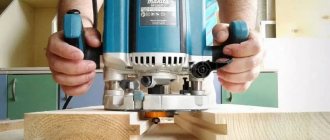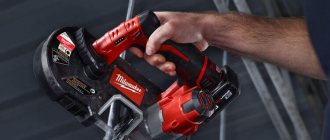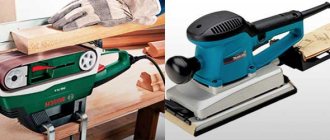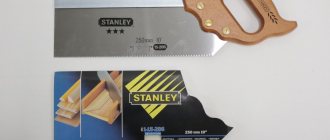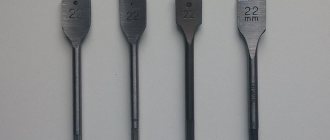If working with wood is your hobby, then it will be useful to know how to choose a manual wood router for your home. Since this is a multifunctional device, in order to understand how to work with it, you need to familiarize yourself with its basic parameters and additional characteristics, as well as functions that are not required but can be very useful. Let's consider all these points in more detail, plus the main types of models and their ratings.
Hand router Source www.bosch-do-it.de
Why do you need a router?
A wood milling machine is a tool that allows you to make cuts, grooves, cut out joints, and also remove a thin layer of material. This tool is used in carpentry, when constructing furniture and when working with parquet or laminate. With its help, you can make longitudinal edges, complex patterns, tenon joints, and also cut grooves for dowels and dowels.
Why you need a router can be understood if you understand its varieties and structure, as this will help you choose the necessary tool.
Circular groove Source m-stone.ru
Types of cutters used
Each type of material being processed requires the use of an appropriate attachment. Externally, the cutter consists of two parts: the cutting edge (working part) and the shank. It is important to know that pliable soft woods are processed with attachments made from lightweight materials, while hard wood species require an appropriate hard cutter.
There is another classification of nozzles:
- profile - simple processing of wood products;
- cone-shaped - processing at an angle;
- rectangular - working with grooves;
- V-shaped to produce holes with a 45-degree slope;
- disk - you can create different grooves in width and depth;
- molding will help to round the edge;
- rebated for quarter milling;
- “swallow’s nest” – tenon joints;
- fillets to create details of the same name on the edges.
It is worth knowing: for a manual household router you should use bearingless attachments - this will help in processing tools in any convenient place.
Types of router
To choose which hand router is suitable for a given purpose or intended for universal use, you should familiarize yourself with the manufacturing options of this tool and what each of them is used for.
Types of attachments Source perego-shop.ru
Rod
The submersible model has a body that is mounted on a special rod, along which it can move vertically. A support mechanism is attached to the bottom of the guide. The entire unit is placed on it and, using the side handles that need to be pressed, it is immersed in the material.
After finishing the work, release the handles and the router will rise up under the pressure of the springs. It can be used to make grooves, cutouts, holes or joints, as well as curly patterns. Due to its high functionality, this model is considered universal, but the increased weight does not allow it to work well in vertical areas. Working with a router for beginners with this tool will be simpler and more understandable.
Tool with immersion mechanism Source i.allo.ua
Edging
An edge tool (trimmer) is capable of working not only on horizontal surfaces, but also on vertical ones. Most often it is small in size, so it can be used with one hand. The body itself has a narrowing and a special rubberized coating. This is necessary to use it as a handle.
The bottom of the device has a sliding surface to prevent scratches and also for smoother movement. The immersion depth of the cutter is changed using a special scale. With this tool you can use additional attachments: a rip fence - for processing the edges of a part or corners, as well as a copying sleeve, which allows you to make cuts according to a template.
Using this tool, you can process laminated or veneered parts, select grooves, round corners, fit blanks, and make shallow cutouts for decoration. The trimmer is recommended for use in workshops that require daily edging work.
Edging router Source www.rucne-naradie.sk
Lamellar
The body of such a tool has a horizontal body and is similar in design to a grinder. At the bottom it has a mechanism for operation, and a wide handle is attached above it. This model is equipped with a disk cutter for cutting into wood. To work, you need to press the tool on the material to immerse the cutter inside. Thus, you can make a special groove for attaching oval parts (lamellas).
It is recommended to work with a manual router of this type for making grooves or trimming parts. This machine is not suitable for rare use, since its purchase will not pay for itself. Therefore, you should choose such a model for frequent use in workshops for which it is needed every day.
Lamellar router Source laukar.com
Additive
This type of milling tool is similar in shape and design to a lamellar one, but there is a significant difference in its mechanism. To operate, this model uses 2 spiral cutters that work on the principle of a drill. With their help, an accurate connection of parts is made, since they cut into the material at a certain distance from each other. When immersed, the tips cut grooves into which dowels can be installed.
This type of tool is used in furniture production to connect parts whose fastening areas need to be made invisible. The cutter for this tool can be dowel or dowel. With their help, you can make holes for detachable and non-demountable connections.
Filler milling machine Source harrer.at
Rotary
This type of tool is similar in operating principle to a rod tool, but has a smaller size and a narrowed body, like an edging tool. It can be used for woodworking or ceramic tile work. It is also capable of processing plasterboard floors, chipboard, plastic and soft types of metal. Its speed reaches 30 thousand per minute, which makes it possible to work with hard materials.
The small size of the device makes it possible to work with a manual wood router using one hand, since its weight is small. When replacing a cutter, you can install a diamond rod or a cutter for working with ceramics. Using this type of tool, if it is equipped with speed control, work is performed on materials of varying densities, for example, cutting holes or processing edges.
Rotary router Source allegroimg.com
Which manufacturer should you prefer?
A milling cutter is chosen not only by technical characteristics. Two more factors: price and brand reputation. If there are no restrictions on the purchase amount, you should choose well-known brands with a long history. And that's why:
- Such companies have been developing and improving their products for many decades. They have special design bureaus, testing laboratories, and a strong staff of design engineers. As a result, it is these brands that achieve the best performance in all areas: ergonomics (ease of use), efficiency and productivity.
- Famous brands value their reputation. Only manufacturers for whom reputation does not matter can throw a batch of defective milling cutters onto the market under a new name and then disappear. There are many well-known brands, and they constantly compete fiercely with each other, which also stimulates improvement of product quality and, if possible, keeping prices to the minimum.
The two most famous brands in this area are the European (German) Bosch and the Asian (Japanese) Makita. It is quite possible that their production facilities are located in China today. But full control over quality is maintained; equipment, designs, and technologies belong to the brands.
Today, when purchasing such milling cutters, the main thing is to avoid counterfeit goods, which can also be produced in China under the brand label, but in other production facilities.
Main characteristics
Working with a milling cutter largely depends on the characteristics of the tool. The weight of the device is directly related to its power, since the more power there is, the heavier and larger the motor inside the case. The maximum size and length of the cutter also depends on the engine power. It also gives rise to the classification of tools by size:
- a device weighing 2-3 kg and a motor of 420 - 750 W is considered light;
- a medium-sized milling cutter has a power from 800 to 1450 W and a weight of up to 5 kg;
- a tool is considered heavy if it has a 1500-2300 W motor installed and its weight starts from 6 kg.
Professionals give advice for dummies on how to choose a manual wood router for the home, after analyzing the volume and complexity of the work. Beginners should opt for a lightweight instrument, as it is easier to learn.
Small device Source cdnmedia.220-volt.ru
Its heating speed also depends on the power of the device: the weaker the engine, the faster it heats up. Therefore, to make deep cuts or frequent milling, you should use a tool that has a motor of 1500 W or more installed.
If there is a choice of models whose power differs by no more than 200 W, then you should choose the one with the maximum power, since it will be able to work under the same loads and not overheat.
One of the important parameters for working with a milling cutter on wood or hard material is the number of revolutions it makes in 1 minute. (rpm). Most often, the device has a function for changing the speed, since in its absence it will become less universal and will not be suitable for all materials.
To operate, the milling cutter can use speeds from 3 to 35 thousand rpm. Also, the number of rotations depends on the diameter of the cutter. When working with thick cutters, you should reduce the speed to prevent the material from burning. It is necessary to work with hard rocks at low speeds, since the high density of the material may cause the tool to break.
Option for working with tiles Source domagazine.ru
The working stroke of a cutter is the depth to which the cutter can be immersed. For small models, the maximum value of this parameter reaches from 30 to 50 mm, and for large ones – 80 mm. The higher this value, the larger and heavier the device will be.
It is impossible to cut a deep groove on the first pass, so tools of different sizes are required. First, a 3 mm groove is made with a light tool. Next, the groove is deepened using a medium-sized bottom milling cutter to a depth of up to 6 mm, after which a heavy unit is used to increase the groove to 8 mm or more.
It is impossible to make a groove whose depth is greater than the working stroke, but it is possible to make a groove less. To do this, you need to change the inclination of the vertical stop using a special regulator, which is installed in the upper part of the tool. With it you can adjust the depth with an accuracy of 0.1 mm.
Adjusting the working stroke works the same for all types of cutters. Using a special stop, the immersion stops the moment the cutter reaches the desired depth.
Choosing a tool with prospects for use as a milling machine
Manual models are sometimes used in stationary mode. Place the routers on the table in an inverted position, with the cutter facing up above the work table.
In stationary mode, the router remains switched on longer than in manual mode. Therefore, “motor resource” is important, the ability to work for a long time without rapid wear. The electric motor should not overheat. Large sample sizes contribute to overheating of a weak engine. Therefore, the router must be powerful enough to handle heavy loads without overheating.
The Makita 3612 C described above is suitable for these purposes . If there are no restrictions on the purchase price, you can use the professional model BOSCH GOF 1250 LCE Professional + L with an average power of 1250 W, costing more than 40 thousand rubles.
For small, rare jobs, it is better to use a budget milling cutter of medium power.
You cannot expect that a manual milling cutter with a brushed commutator motor will operate in a stationary mode in the same way as machines with asynchronous motors. But for a small sample, when manufacturing expensive products, this option is quite suitable.
Precisely selected power tools are the key to successful work. The modern market offers the widest selection of milling cutters. Knowing the criteria by which to choose, you can slowly select the right option.
Equipment and additional features
Using variable equipment, you can simplify and speed up wood milling work:
- A rip fence is a device that helps you rout areas that run in the same direction as the edge of a part. It is attached to the working edge of the tool using 2 rods and secured with screws. The accuracy with which you can adjust the position of the cutter and how high-quality the cut will be depends on how tightly this part is tightened. Depending on the model and manufacturer, the number of screws varies from 2 to 4.
- A cutter may have several cutting edges. An increase in the number of cutting surfaces affects the accuracy of the groove made, and a decrease affects the speed of its cutting. Most often, the kit comes with a cutter for 2 cutting edges, but these surfaces can be from 1 to 4. It is recommended to use a tool with 1 knife for rough work, and finish it with a cutter with 4 surfaces.
Types of incisors Source p0.zoon.ru
- The cleanliness of the processing and the cutting speed depend on the level of inclination of the knives on the cutter. There are straight and oblique cutting surfaces. The second option makes the holes more accurately and can be either left or right inclined. One produces more accurate chip removal, and the second produces high-quality cuts.
- The milling cutter sole is the part that will be in contact with the material. It must have increased strength to support the cutter's own weight and operator pressure. Most often they are made of cast or stamped metal, less often of plastic, since it is very fragile. The cast part is installed on expensive models, and the stamped part on cheaper ones. A smooth plastic cover is installed on top of it, which should prevent scratches and make the movement of the tool easier and smoother. If the nozzle breaks, it can be replaced with a similar one, or one made independently from scrap materials, for example, plywood.
- The miter gauge and compass can be used for rounding parts, finishing corners and cutting round parts of different sizes.
Compass for cutter Source 7routertables.com
- The guide bar is similar in properties and operating principle to the side stop, but it can be fixed independently of the edge of the workpiece. The length of removal from the material is adjusted using a special ruler, which is secured with clamps. An attachment is installed on the router itself, which moves along the cells in the ruler.
- The copy sleeve and ring are used together. The first part is needed for complex figured cutting according to a drawn template. During operation, the edge of the device rests against the border of the design, which is why the copy will come out slightly larger than the original template. The ring is needed to close the groove for the bushing if it is not needed.
- The guide rod is a mechanism for smoothly immersing the cutter into the material. It is installed on vertical type devices. With the help of springs installed inside it, the unit is lifted automatically and smoothly. Manufacturers often equip rods with a protective casing that prevents dust from entering the structure.
Auxiliary devices used at work
Filigree precision during the procedure is achieved by auxiliary devices:
- parallel or side stop - used for milling along the edge of the workpiece, helps to guide the line evenly;
- guide rail - installed at any distance from the edge edge, used for processing along straight lines;
- copy sleeve - duplicates the contours of the template, creates an enlarged copy of the item;
- ruler-compass - necessary for creating radial lines, allows you to create rounded objects.
To keep the cut area clean, a pipe is used to connect to a vacuum cleaner.
Copy sleeve
Video description
This video shows useful additional devices:
- Adjustment of the cutting depth should be installed on all models of the tool, since it is possible to use a wood router with high precision only with the help of this part. The regulator should have a scale with marks, and the more accurately you can adjust the depth, the better the cut will be. Most often these divisions are made in millimeters, but they can also be in inches. The most precise products can change the depth of immersion by 0.1 mm. For more convenient changes, it can be equipped with a special screw. This part is usually made in the form of a rod, with which the router rests on the part when the desired depth is reached.
Device with regulator Source i.pinimg.com
Video description
This video shows the main characteristics when choosing a router:
- A system that allows the cutter to start moving smoothly rather than jerkily can help avoid overloading the device when starting work. It also helps to process parts more accurately and prolongs the life of the cutter.
- An electronic device for automatically adjusting speed during operation is capable of maintaining the desired speed if a harder section of material, for example a knot, appears in the path of the cutter. This mechanism stabilizes the operation of the cutter and improves the quality of processing.
- The temperature control module is a very important design element when choosing a router, as it is responsible for the safety of the device. When the mechanism overheats, it automatically turns off the current supply to the motor. Instead, to reduce the cost of the design, a color indicator can be installed, which will show how overheated the unit is.
- Before choosing a router for working in a confined space, you should check whether it has LED lighting for the area in which the work will take place. This is necessary to use the device in places with limited lighting.
Tool with LED backlight Source prosto-instrumenty.ru
- The power cord is a very important element of the router. Its length should be long enough to make it convenient to work at a distance from the outlet. It is necessary that it does not interfere with work and visibility. A wire braided with reinforced thread will be stronger and more durable.
- A mount for installing a nozzle, which makes it possible to connect a construction vacuum cleaner, will help clean the work surface from dust and debris during work. This will protect the device from unnecessary damage, as well as improve visibility and simplify operation.
There are various attachments for installation on the device, since using a router on wood or other material requires the help of special cutters, because each of them can make a cut of a different shape:
- A straight groove cutter is made in the form of a cylinder and is needed for rectangular grooves.
- The U-shaped bit is used for a rounded groove, which is made using a hand-held device.
- A V-shaped cutter can make a groove at different angles of inclination of its walls. To do this, several such nozzles of different sizes are used.
V-shaped cutter Source cdn.vseinstrumenti.ru
Ergonomics
Each manufacturer tries to arrange all the components as compactly as possible, and in such a way that it is as convenient to use the tool as possible. This works out differently for everyone. For example, Makita. Milling cutters from this manufacturer are pleasant to hold in your hands.
- centering (weight distribution) is maintained, the tool does not tip to the side, it does not need to be held with force;
- light weight;
- compact dimensions;
- depth adjustment is convenient.
As a result, working with such a tool is pleasant.
Other leading brands also have good user friendliness.
Cheap, low-quality routers can be clunky, bulky, and difficult to use.
It is better to hold the router before purchasing in a real store. By the way it fits in your hands, you can immediately assess the quality based on ergonomics. When purchasing online, you can only evaluate ergonomics by reviews.
Replacement of carbon brushes for different brands is organized differently:
- without disassembling the case, through the plug screws on the case;
- with disassembly of the housing.
The first option is much more convenient. But carbon brushes are rarely replaced. It happens that they last the entire service life of the router itself. Therefore, the replacement method is not very important.
The location of the power cord outlet and its length are important. A short cord will require an extension cord. If the lead is poorly positioned, the wire will interfere with work and there is even a risk of getting into the cutter.
Choosing a wood router
Below is information on which manual wood router to choose for home use and their rating, which will help you get acquainted with the models:
- Bosch GMF 1600 CE
It has a high cost and comparable quality. This model has a 1.6 kW motor and a drive that can immerse the cutter by 75 mm. The speed controller allows you to change their number from 10 to 25 thousand rpm. The immersion fixation scale allows adjustment with an accuracy of 0.1 mm.
This device weighs 4.3 kg and has LED backlighting. You can connect a vacuum cleaner to it, and it also has a turret and is able to maintain a constant speed under load.
- Makita RP1800F
Weighs 6 kg and can immerse the cutter 70 mm. The engine power is 1.85 kW. The speed can be adjusted from 10 to 22 thousand rpm, and the power cable length is 4 m.
The disadvantage of the device is the presence of only one collet, which is supplied in the kit. This one can regulate constant speed and lock the spindle under load, and it also has a turret.
Model Makita RP1800F Source 24ima.ru
- Hitachi M12V2
It has a 2 kW motor with the ability to deepen the cutter by 65 mm. The set includes 12 and 8 mm collets.
The disadvantage of the device is the rough change in immersion depth. The length of its power cable is 3.8 m. This milling cutter has a function for maintaining a constant speed under load, a speed control from 8 to 20 thousand rpm, as well as a turret stop and spindle locking under pressure.
When choosing a router, you should pay attention to whether such a model has adjustment of speed and precise immersion depth. These parameters improve the versatility of the device and make it possible to make more regular grooves.
Model Hitachi M12V2 Source www.skypka1.com
Briefly about the main thing
A milling cutter is a device for processing parts and making grooves in them. It can be used to make chamfers, locking joints and figured carvings.
The most universal device is considered to be a plunge router, while the most professional and highly specialized devices are the lamellar and filler milling machines. Rotary and edging routers are needed for working in confined spaces or for special jobs.
The choice of a router directly depends on its functionality and what additional functions it has.
